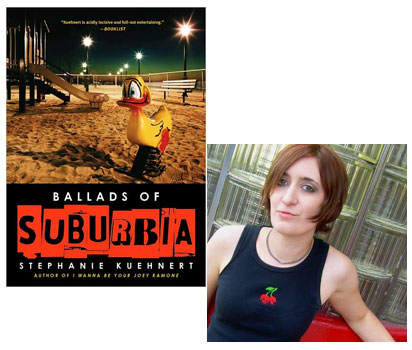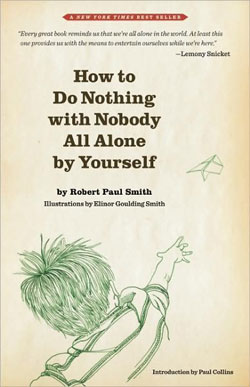Stephanie Kuehnert Picks Out Some Ballads

When I was thinking about ways I could invite Stephanie Kuehnert to talk to Beatrice readers about the inspiration for her second YA novel, Ballads of Suburbia, I remembered that we were coming up on the holidays, and gift ideas are always helpful this time of year, right? So I asked Stephanie if she would be willing to recommend some of her favorite ballads, songs with the sense of emotional energy that drove her fiction, and she was totally up for it—and there’s one recommendation here I can totally get behind, one that I can understand even if my enthusiasm isn’t as intense as hers (but that may just be because I haven’t heard the CD in a decade), and one that I’d never heard before but I’m absolutely going to check out.
When Kara, the main character in Ballads of Suburbia, talks about ballads, she says, “I’m not talking about the cliched ones where a diva hits her highest note or a rock band tones it down a couple of notches for the ladies. I mean a true ballad. Dictionary definition: a song that tells a story in short stanzas and simple words, with repetition, refrain, etc. My definition: the punk rocker or the country crooner telling the story of his life in three minutes, reminding us of the numerous ways to screw up.”
Even though Kara is not a fictionalized version of me (I swear!), she and I do share the same definition of a ballad. So keep this in mind while reading over my recommendations for albums with great ballads. This is why you aren’t going to find the soundtrack to The Bodyguard on my list or any hair metal albums. (Though I do have a big soft spot for “Every Rose Has Its Thorn” by Poison; I’m not gonna lie.) Think of these as my favorite storytelling albums.
8 December 2009 | guest authors |
Read This: How to Do Nothing with Nobody All Alone by Yourself
 David Mamet was born in 1947. He was eleven years old when Robert Paul Smith’s How to Do Nothing with Nobody All Alone by Yourself was published in 1958. I’m not able to get in touch with Mamet to ask him if he read this book, but I am willing to bet folding money that he did, then or shortly after. Basically, this is a book that gives young boys ideas about how to entertain themselves when they don’t have anybody else to play with, starting out by making a spool tank and ending with a spring trap constructed from a wishbone, chewing gum, a burnt match, and a rubber band. Of the hundred or so pages in between, at least a dozen are dedicated to the rules of mumbly-peg; you can understand why this new commemorative edition features a huge legal disclaimer on the back cover flap.
David Mamet was born in 1947. He was eleven years old when Robert Paul Smith’s How to Do Nothing with Nobody All Alone by Yourself was published in 1958. I’m not able to get in touch with Mamet to ask him if he read this book, but I am willing to bet folding money that he did, then or shortly after. Basically, this is a book that gives young boys ideas about how to entertain themselves when they don’t have anybody else to play with, starting out by making a spool tank and ending with a spring trap constructed from a wishbone, chewing gum, a burnt match, and a rubber band. Of the hundred or so pages in between, at least a dozen are dedicated to the rules of mumbly-peg; you can understand why this new commemorative edition features a huge legal disclaimer on the back cover flap.
Here’s an example of why I’m pretty sure David Mamet read this book growing up:
“One of the things that I found out when I was writing this book was that an artist can’t draw a picture of something without seeing it. I talked my wife into doing the drawings, and I’ve spent about a month now in making all the things in the book so she could draw them. Fortunately for me, I was doing this in the fall, and I could tell her that the reason I couldn’t make a willow whistle was because the only time to make willow whistles was in the spring. If you want the real truth, I never even knew a kid who could make a willow whistle. But there were books in the lbirary that told how to make a willow whistle, and I used to try. The only reason I’m even mentioning this is that people I’ve talked to claimed they knew a kid when they were kids who was able to make willow whistles. Maybe I’m just a dope about willow whistles and you’ll be very good at making them. But everything else in the book I’ve made. I made them when I was a kid, and I made them again as a grownup, and they work. This is a guarantee.”
Hell, after reading this book, I want to go out and get a penknife and start playing mumbly-peg. Which, oddly enough, I never did do when I was in the Cub Scouts and had a penknife. Boy, did I miss out. Also, I want an old shoelace and a horse chestnut so I can make a conker. And I wouldn’t be averse to making that spool tank. It’s a really wonderful book, and one of the great things about it is that Smith is constantly telling kids that “just plain going to the library and getting out a book is a swell thing to do,” and that they’ll learn a bunch more things than the things he teaches them, and they should look forward to that. Because the greatest skill How to Do Nothing with Nobody All Alone by Yourself teaches isn’t mastering the various levels of mumbly-peg, it’s about learning how to be content with yourself without anybody else around.
(Officially, from what I can tell, this book isn’t coming out until next March, which is funny because I’ve got a finished copy right here in my hands, but go figure. Just mark the date on your calendar already.)
7 December 2009 | read this |

 Our Endless and Proper Work is my new book with Belt Publishing about starting (and sticking to) a productive writing practice.
Our Endless and Proper Work is my new book with Belt Publishing about starting (and sticking to) a productive writing practice. 
